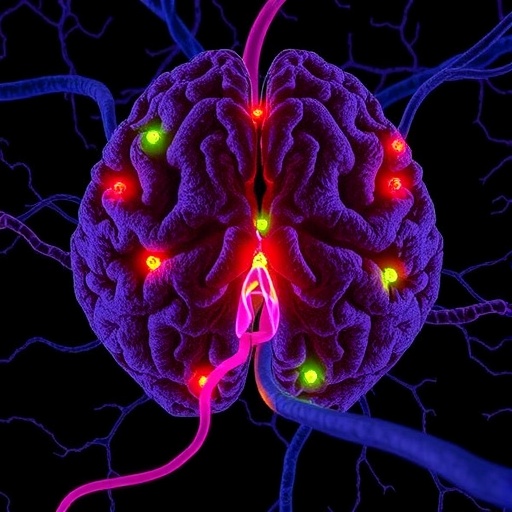
In the relentless quest to unravel the complexities of Parkinson’s disease, a groundbreaking new study sheds unprecedented light on the molecular adaptations occurring within the brain’s circuitry as the disease progresses. Researchers Nielsen and Ford have meticulously charted the intricate changes in muscarinic M4-receptor signaling along the direct pathway neurons of the basal ganglia, revealing how these postsynaptic adaptations closely shadow the spatiotemporal pattern of dopaminergic degeneration. Published in npj Parkinson’s Disease, their 2025 paper offers a fresh perspective that may redefine therapeutic strategies for this debilitating neurodegenerative disorder.
Parkinson’s disease, fundamentally characterized by the progressive loss of dopaminergic neurons within the substantia nigra pars compacta, disrupts the delicate balance of motor control pathways that orchestrate voluntary movements. The basal ganglia, a constellation of subcortical nuclei, serves as a critical hub for this regulation. Of particular interest is the direct pathway, a neural route that facilitates motor initiation through excitatory signals to the thalamus. Within this pathway, muscarinic M4 receptors—a subtype of G-protein coupled acetylcholine receptors—play a vital modulatory role. Understanding how these receptors adapt postsynaptically as dopaminergic neurons deteriorate offers essential clues into the progression of motor deficits seen in Parkinson’s.
Nielsen and Ford’s investigation delves into the temporal sequence of changes in M4 receptor activity coinciding with progressive dopamine depletion. Using advanced electrophysiological assays combined with region-specific mapping in animal models that mimic Parkinsonian degeneration, the study demonstrates that postsynaptic M4 receptor signaling does not undergo uniform alteration throughout the basal ganglia. Instead, these neurochemical adaptations emerge in a sequential, regionally confined manner—mirroring precisely the pattern of dopaminergic neuron loss observed in clinical and pathological settings.
.adsslot_lLGxfem36v{width:728px !important;height:90px !important;}
@media(max-width:1199px){ .adsslot_lLGxfem36v{width:468px !important;height:60px !important;}
}
@media(max-width:767px){ .adsslot_lLGxfem36v{width:320px !important;height:50px !important;}
}
ADVERTISEMENT
This revelation contradicts previously held assumptions that postsynaptic receptor adaptations are homogenous or static. Instead, it suggests a dynamic synaptic remodeling process that could either compensate for or exacerbate dopaminergic deficits. The direct pathway neurons, primarily expressing D1 dopamine receptors, are known to become hypoactive as dopamine declines. Between these neurons and their cholinergic modulators, the M4 muscarinic receptor signaling axis may act as a critical regulatory node. The study’s findings point towards a possible homeostatic plasticity mechanism—alterations in M4 receptor expression or activity may serve as an intrinsic attempt by neural circuits to recalibrate excitability amid the neurodegenerative milieu.
On a molecular level, the paper details changes in receptor density, G-protein coupling efficiency, and downstream signaling cascades, including the modulation of adenylate cyclase activity and intracellular cAMP concentration. These adaptations correlate temporally and spatially with the severity of dopamine depletion, delineating a tightly orchestrated sequence of synaptic alterations. This insight is particularly revolutionary because it highlights targetable molecular pathways that could be leveraged for symptomatic relief or neuroprotection.
From a regional perspective, the authors mapped the progression of M4 receptor adaptations across different basal ganglia subregions, including the dorsal striatum and other subdivisions heavily impacted by Parkinsonian pathology. These data underscore the heterogeneity within the striatum itself—a region not uniformly affected by dopaminergic loss—suggesting that therapeutic interventions need a precision-targeted approach rather than a one-size-fits-all strategy.
Moreover, the study contrasts the behavior of M4 receptors in the direct pathway with that of muscarinic receptors in the indirect pathway, thereby advancing our understanding of how cholinergic modulation diversifies within basal ganglia circuits. Given that the direct and indirect pathways exert antagonistic roles in motor behavior, the differential regulation of their muscarinic receptors could be pivotal in the expression of Parkinsonian motor symptoms, such as bradykinesia and rigidity.
Notably, the authors also emphasize that postsynaptic adaptations in M4 signaling may influence synaptic plasticity mechanisms beyond receptor density, potentially impacting long-term potentiation and depression within striatal neurons. This nuanced understanding connects molecular signaling changes to broader network-level dysfunctions, offering a mechanistic bridge from receptor biology to circuit dynamics.
The translational implications of these findings are profound. Current pharmacological treatments for Parkinson’s largely focus on replenishing dopamine or mimicking its action, often with limited efficacy and significant side effects. Targeting muscarinic M4 receptors offers an alternative or complementary therapeutic avenue, potentially restoring electrophysiological balance in the basal ganglia pathways altered by degeneration.
Furthermore, the study’s approach—employing region- and time-specific analyses—advocates for the development of temporally adaptive treatments that evolve alongside disease progression. By tailoring interventions to the changing neurochemical landscape, clinicians might improve motor outcomes and mitigate side effects associated with generalized therapies.
In addition to therapeutic insights, this work opens new vistas for biomarkers development. If postsynaptic M4 receptor adaptations correspond closely with dopaminergic loss patterns, monitoring these changes could aid in diagnosing disease stages or in tracking the efficacy of interventions over time. Advanced neuroimaging or molecular assays could be designed to detect such adaptations non-invasively, moving clinical practice closer to precision medicine models.
The methodology employed by Nielsen and Ford represents a tour de force of molecular neuroscience techniques, blending in vivo electrophysiology, receptor binding assays, and sophisticated computational modeling to produce an integrative picture of synaptic remodeling. Such interdisciplinary approaches set a new benchmark for future studies aiming to decode the complex cellular responses underpinning neurodegeneration.
Critically, the study also acknowledges limitations, particularly concerning the extrapolation of animal model data to human pathology. While rodent models provide valuable mechanistic insights, the heterogeneity inherent in human Parkinson’s disease—both in symptomatology and progression—necessitates cautious optimism. Future research must validate these findings in human tissues or advanced humanized models to fully harness their clinical potential.
To conclude, Nielsen and Ford’s seminal contribution elucidates a previously underappreciated aspect of Parkinson’s disease pathophysiology—the dynamic, localized adaptation of postsynaptic muscarinic M4 receptor signaling within direct pathway neurons. Their work not only enriches the scientific understanding of basal ganglia circuitry alterations but also paves the way for novel therapeutic strategies that may one day transform patient care by finely targeting the molecular nodes of degeneration.
As Parkinson’s research accelerates towards increasingly sophisticated molecular and circuit-level insights, such studies underscore the necessity of prioritizing synaptic adaptations within disease models. The brain’s remarkable plasticity, even amidst neurodegeneration, may hold the keys to developing interventions that not only alleviate symptoms but potentially slow or halt disease progression altogether. This pivotal paper, therefore, stands as a beacon, illuminating new paths in the effort to combat one of the most challenging neurological disorders of our time.
Subject of Research: Postsynaptic adaptations in muscarinic M4-receptor signaling within the direct pathway neurons of the basal ganglia during Parkinsonian dopaminergic degeneration.
Article Title: Postsynaptic adaptations in direct pathway muscarinic M4-receptor signaling follow the temporal and regional pattern of dopaminergic degeneration.
Article References:
Nielsen, B.E., Ford, C.P. Postsynaptic adaptations in direct pathway muscarinic M4-receptor signaling follow the temporal and regional pattern of dopaminergic degeneration.
npj Parkinsons Dis. 11, 186 (2025). https://doi.org/10.1038/s41531-025-01047-3
Image Credits: AI Generated
Tags: basal ganglia circuitrydopaminergic neuron degenerationexcitatory signaling in motor initiationG-protein coupled receptors in neurobiologyM4 muscarinic receptor signalingmotor control pathways in Parkinson’sneurobiology of movement disordersneurodegenerative disorder adaptationsParkinson’s disease researchpostsynaptic receptor changesspatiotemporal patterns of degenerationtherapeutic strategies for Parkinson’s





